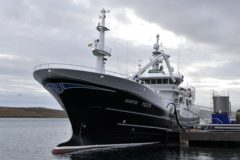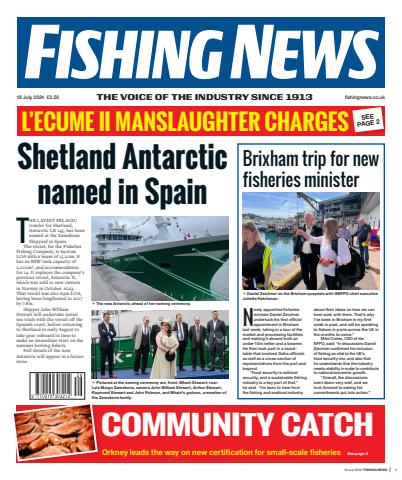Futureproofing the industry is going to involve both reducing seafood impact on climate and adapting to climate impact on seafood, writes Angus Garrett, head of horizon scanning at Seafish
You can’t access many newsfeeds these days without some mention of carbon emissions and the climate ‘emergency’. Global climate change is now recognised as a major challenge for the world, prompting a call for action by government, industry and wider society.
What seems to get lost in the noise is that climate change is interlinked with other global challenges such as food security.
A warming climate must be addressed, but the world still needs to be fed. The marine environment plays an important role in regulating the global climate. It is also an important food source.
In the search for reduced emissions, food can be an easy target. All food production relies on natural resources, and it turns out that food makes a sizeable contribution to global climate change – some 20-30% of all human-derived emissions.
This brings climate and food production into sharp focus. Can we address global climate change and feed the world at the same time?
What matters is the impact of different food production systems. In the round, almost half of food- related emissions are attributed to livestock. In contrast, it has been estimated that 4% of emissions from global food production can be attributed to fisheries. Seafood emissions are relatively low: the carbon footprint for some species is amongst the lowest for animal proteins. This makes seafood a ‘climate-smart’ food choice – without it, we might have to rely more on higher-impact foods.
Yet, however climate-smart seafood might be, it can also be impacted by a changing climate. This is uncertain territory, because it isn’t clear what changes a warming world will bring, nor when. Some changes are occurring already, such as increasingly severe strorms and waves, and air and water temperature changes. They could aggravate concerns around vessel operation and crew safety, damage to port infrastructure, the distribution of some wild-caught species, and species that can be farmed.
Other changes are longer-term and more uncertain.
More rainfall may be seen in the UK by 2040, whilst sea-level rise and ocean acidification may occur by 2070. This could bring flooding, water quality and salinity issues in nearshore waters, and affect the ability of fish and shellfish to thrive.
Mitigation and adaptation
Despite this uncertainty, climate change is a problem today, not just a potential impact in some distant future.
A focus on reducing emissions, and seafood’s impact on climate, could mean major changes in the seafood supply chain. Efforts to preserve ‘blue carbon stores’ could affect the catching sector – excluding vessels from certain areas, closing some fisheries to allow marine recovery, or restricting fishing to certain gear types.
Reducing transport emissions could affect UK seafood trade – for example, the air-freighting of high-value seafood, since we import most of the seafood we eat and export most of what we catch. More broadly, access to customers or raising capital may be more challenging without carbon credentials.
Although seafood is starting from a good place as a climate-smart protein, there are opportunities to further reduce that low carbon footprint. The industry can focus on making improvements in areas where emissions are relatively high – so-called ‘hotspots’ like fuel use in catching, aquaculture feed, transport by air freight, and yield/ waste from raw materials.
Key steps can, and are, being taken by the industry. These include investing in energy-efficient gear and vessels, looking at alternative lower-carbon feed sources for aquaculture production, and exploring alternatives to air freight by combining cooling technology with sea freight.
However, to ensure a resilient supply of climate-smart food, businesses will also need to adapt to a warming world and climate impacts on seafood. There is no silver bullet, so a range of adaptations are needed. Industry, government and researchers all have a role to play.
Some actions, already underway, are not necessarily prompted by climate change but are helpful adaptations nonetheless. For example, some parts of the fleet are introducing crew enclosures and covered areas, whilst pelagic vessels are pumping from the stern rather than the side. Some ports, such as Peterhead, are investing heavily in port infrastructure that can help defend against storm surges.
Anticipating the potential for flood events, some processors have undertaken contingency planning for worse-case scenarios to ensure customers receive seafood orders. These steps can help the industry cope better with increasingly stormy weather. There are also efforts to better understand the consequences of temperature change.
COP26 and seafood businesses
The climate challenge has been a concern for over 30 years, and will continue to be so for decades to come. The challenge is being considered globally, nationally and at a local level, and may come to dominate our lives and that of coming generations.
At a global level, since the mid-1990s, the UN has co-ordinated the annual Conference of the Parties (COP). The COPs bring governments and others together to assess progress on reducing emissions, and agree further responses.
Over the years, targets have been agreed and ambition set out, most recently – in Paris – to ‘achieve a climate-neutral world by mid-century’. These meetings also provide space for discussion on specific interests, such as how ocean environments should be managed in the face of climate change.
Climate change is also on the agenda at a national level. Commitments to act have already been made by the UK government and devolved administrations, including within the UK Fisheries Act 2020.
These discussions may seem remote and obscure, but they can come close to home. With COP26 in Glasgow this week, there’s already scrutiny on what’s happening in the UK’s backyard.
Those outside the industry are not shy in coming forward to say what should be done, not always recognising the importance of food provision. Decisions may be taken with the best of intentions, only to result in unintended consequences; this is where a focus on the food system will be important.
We need to pay close attention to these discussions and ensure that fishing, aquaculture and the seafood trade are recognised for the important role they play in climate-smart food production.
For more information on climate change and seafood, click here.
This article is from Fishing News’ special feature on industry responses to the climate crisis as part of the COP26 conference in Glasgow. Subscribe to Fishing News here or buy the latest single issue for just £3.30 here.






